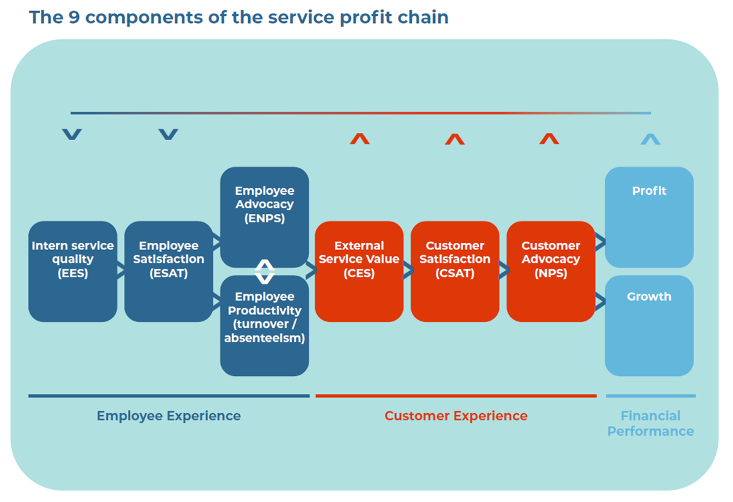by Peter De Clerck and Dorothée Laire, Consultants, Möbius Business Redesign
As Doug Conant, CEO of Campbell’s, once said:
“To win in the marketplace you must first win in the workplace.”Having an engaged workforce is key to deal with accelerated growth, a large transformation, a merger or trying to stay ahead of competition. All organizations face a common challenge: coping with an ever-increasing pressure to innovate, digitize and interconnect across cultures in a new era of globalization. All these innovations and transitions are ineffective without employees that make them happen.
How engaged are your employees and why should you care? According to the
Global Employee Engagement Index 2018, only 29% of employees are engaged in their work and committed to their company. Europe scores a little below average with 27%. This means most employees do not feel engaged or even feel actively disengaged at work. There is significant room for improvement!
Creating better experiences for your employees not only benefits them, it also matters for the sustainability of your organization. A
Gallup study recently stated: “in comparison to the lowest 25%, the top 25% of engaged employees are more productive (+17%), have a lower absenteeism rate (-41%), take better care of customers (+10%) and have even been linked to higher levels of profitability (+21%) and business performance.”
But to influence employee engagement, it is important to understand it.
What is employee engagement?On one hand, employee engagement comes from within and is linked to personal characteristics. On the other hand, we know from experience that situational factors have a big influence on employee engagement.
The Global Employee Engagement Index summarizes these factors into four pillars describing what a company can do to support and stir up employee engagement. The link with the
Shingo Guiding Principles is obvious (Source:
Global Employee Engagement Index 2016).
Inspiring immediate managers. The employee experience is largely determined by the immediate manager or supervisor (N+1). Why?
the N+1 spends a lot of time with an employee;
the N+1 defines the work standards;
the N+1 often has a direct influence on an employee.
Freedom to work and perform (Principle: Respect Every Individual). As a company, you need to create an optimal working environment. Give employees the opportunity to do what they are good at, so they can develop themselves and become even more valuable to your company. Young employees, especially, crave for more freedom, empowerment and growth potential.
A compelling company culture (Principle: Create Constancy of Purpose). Your employees need to fit in your company and its culture in order to feel appreciated and proud of what the organization stands for. Young employees, in particular, pay more attention to the impact (or purpose) of a company. They want to contribute to a meaningful company.
Exceptional leaders (Principle: Lead with Humilty). For employee engagement, confidence in the leader(s) of a company is vital. This is the most important driver for employee engagement. When employees have confidence in the top management, they can be sure they’re treated fairly and with respect. That positive energy channels into their work.
The Service Profit Chain (Principle: Create Value for the Customer)What are the effects of higher employee engagement on your customers and organization as a whole? Employee engagement, customer satisfaction and business performance are all linked. The Service Profit Chain, a model by Heskett, Sasser & Schlesinger, was first introduced in the
Harvard Business Review more than 25 years ago (1994). Three years later, Heskett et al. published their book:
The Service Profit Chain. How leading companies link profit and growth to loyalty, satisfaction, and value.
The figure above visualizes the nine components of the service profit chain and how they link to each other. The metrics matching the components are mentioned as well. This model gives a clear idea on how happy employees create happy customers and better results for your company.
Monitoring the employee experience is key!
Scientific thinking should not be limited to operations only. The principle can be applied to improving employee experience and customer satisfaction as well. We believe it is essential to measure both employee and customer experience in a structured way. We recommend following these four steps:
1. Gather feedback via continuous micro-surveys
2. Collect data
3. Analyze the data and gain insights
4. Act and improve
If you want to know more about improving Employee Experience, read Möbius’ miniguide. It explains why companies should care about employee experience and provides further details on the link between customer and employee experience, amongst others.
Link :
https://www.mobius.eu/en/downloads/mini-guide-on-employee-experience/About the authorsPeter De Clerck assists companies within the public and private sectors and is passionate about strategy and operations and guiding organizations in delivering value and impact for the customer where it matters the most. Peter is a consultant at Möbius Business Redesign. You can contact him at peter.declerck@mobius.eu.
Dorothée Laire assists companies within the public and private sectors and is passionate about the customer and employee experience. She guides organizations in delivering value and impact for the customer. Dorothée is a consultant at Möbius Business Redesign. You can contact her at dorothee.laire@mobius.eu.
